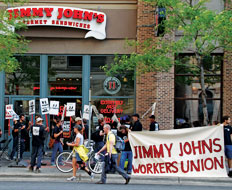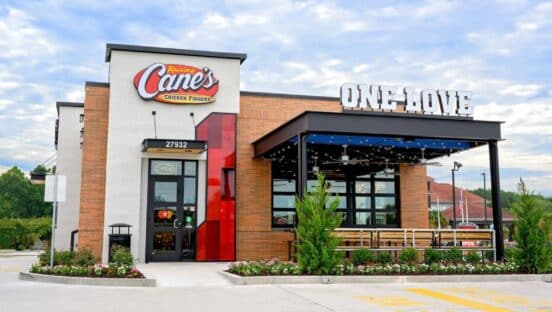Jimmy John’s boasts more than 1,000 stores nationwide, claiming an army of sandwich makers and delivery drivers that matches that of most of America’s quick-service companies. Last fall, however, overwhelming attention zeroed in on just 10 units in the Minneapolis area.
On October 22, the National Labor Relations Board (NLRB) announced the results of 174 Jimmy John’s employee ballots for unionization. The sandwich company held its breath; so, too, did many in the quick-service category. Unionization would spur sweeping changes in employment practices across the quick-service landscape, while a dominant anti-union vote would do much to silence organized labor’s efforts to break into the elusive quick-service base.
Although the Jimmy John’s measure was defeated—87 votes cast against the union, 85 for, and two ballots challenged—the Industrial Workers of the World (IWW), the guiding force behind the Jimmy John’s unionization push, has vowed to continue the fight.
“Our goal is to bring working conditions in quick-service restaurants in line with standards of respect and dignity in other industries,” says Erik Forman, a Starbucks and Jimmy John’s employee who, as an IWW volunteer, actively organizes campaigns at both workplaces. “We think workers deserve decent wages, consistent scheduling, sick days, and increased job security. With the profit margins of most fast food chains, we feel these are reasonable demands.”
The IWW’s steadfast attitude—combined with the growing influence of social justice organizations that campaign for similar labor issues—presents a challenge to a quick-service industry still looking to rebound from the recession.
A Checkered Past
The first modern-day whiff of unionization in the quick-service ranks came in 2003, when Starbucks employees in New York City attempted to organize.
Although unions have been able to organize labor in other sectors of American society—civil-service employees, manufacturing, and education among them—infiltrating the quick-service industry has so far proved unattainable. A youthful workforce, transient employees, and new workers, including immigrants, unwilling to pay dues have all worked against organized labor’s efforts. So have smaller, isolated employment groups and the sheer time it takes for a union to get in, negotiate a contract, and deliver benefits for a notoriously high-turnover employment group.
Yet, quick-service restaurants possess some of the traditional elements that stir organized labor: low wages; few, if any, benefits; and a working environment that presents several dangers. Aaron Kocher of the IWW Starbucks Workers Union contends that the low pay and dangerous conditions in quick-service restaurants highlight the necessity of unions to protect workers’ rights.
“Some people have the idea that unions are necessary in some industries, but not in others,” he says. “This all comes down to workplace democracy and about giving workers a voice, as they should have a 100 percent expectation for being treated fairly and with respect and dignity.”
By and large, today’s organized labor groups have adopted a new approach. They’re taking to traditional media as well as social media, utilizing research and data to drum up favor, and inviting religious and educational institutions to work with them on protests and lobbying. They are, critics say, not averse to intimidation or skewing facts to their favor, eager to gain negotiating pull wherever and however necessary.
“These are not your great-grandparents’ unions of postal and textile workers,” says Carolyn Richmond, cochair of Fox Rothschild LLP’s Hospitality Practice Group in New York. “They’re following a different model and redefining organizing efforts for this century. They want bigger-picture reform rather than battles with specific restaurant groups.”
“You’ll see some decent theater, but the unions have simply failed to resonate with employees,” says Andrew Rolfes, a Philadelphia-based labor and employment attorney.
Despite unfavorable results, many workers and their union partners remain committed. Kocher says the IWW will continue to build on its successes and refine its model, perhaps inspiring new employee groups to emerge.
“We’re trying to set a new precedent. Starbucks was the spark showing it was possible and should be done,” says Ayo Collins, an IWW Jimmy John’s Workers Union member.
If unions were to infiltrate the quick-service ranks, the impact would be significant, particularly for mom and pop operations that would struggle to meet the wage and benefit demands of organized labor. While most operators want to provide positive employee relations in a safe working environment, any aggressive resistance would stem from the massive cost increases union laborers would require.
“You can’t force a business to stay in business if they can’t afford it,” Richmond says.
What the Future Holds
While Starbucks remains locked in a multiyear unionization battle and Jimmy John’s October vote was organized labor’s first close call in the quick-service arena, many say unions in this sector will continue to fall flat. Rolfes points to the influential Service Employees International Union’s reluctance to enter quick-service battles and falling union penetration across the country as noteworthy trends.
Still, efforts remain steadfast. The Jimmy John’s group continues to push its “ 10 Point Program for Justice at Jimmy John’s,” which features calls for immediate across-the-board pay raises, consistent scheduling, paid sick days, affordable health care, paid leave for new mothers and fathers, and the release of monthly financial reports.
“We’re all standing together with each other for the same things,” Collins says.
Collins says no business in the customer-service sector can be successful with unhappy, overworked, embattled employees. The union, he says, is necessary to facilitate a positive working environment.
The unions’ continued insistence means restaurants will have to be vigilant, although Collins says an industry-wide wave of unionization is not imminent.
“If you see one union get its foot in the door with a national chain, then you could see some movement, though I’m not convinced one victory will mean a greater tipping point,” he says.
To combat any union potential, Richmond encourages employers to self-audit their restaurants, checking diversity, wage and labor law adherence, and workplace safety conditions, while enhancing communication with employees.
“You want to make sure you don’t need third-party involvement, and a great first defense against such a campaign is to be in accordance with the law,” Richmond says. “Good employers who do right by their employees don’t need a third party.”













